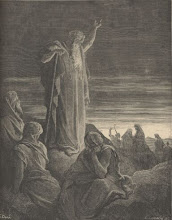The bunny, or hare, has always been a sign of fertility in many ancient cultures. This would explain the association with a fertility goddess and why hares were used in many pagan rituals.
The hare (Easter Bunny), from ancient times was a symbol of the moon, it being a nocturnal animal. The hare is the only animal born with its eyes open. The Egyptian word for hare is "un," meaning "to open." Thus, the hare was associated with the opening of a new season, spring, in April, at the vernal equinox.
The hare and eggs were mutually symbolic in Egypt of the opening of their new year, at which time eggs were ceremoniously broken.
Because of its fertility (one doe can produce up to 42 young a year), the hare is an emblem of fertility, abundance, sexuality, lust, rampant growth and excess.
It became the emblem of gods and goddesses in many different cultures.
Philostratus said the most suitable sacrifice to Aphrodite was the hare as 'it possesses her gift of fertility in a superlative degree'.
Pliny the Elder prescribed its meat as a cure for female sterility and reported that if you ate a hare your body would be sexually attractive for nine days. Hare's genitals were carried to prevent barrenness.
Through the centuries stories of the hare abound in relation to the moon and the springtime. If Eostre/Easter was the goddess of spring and the dawn, representing a rebirth of life on the earth, then it would make sense that the highly reproductive hare was associated with her. The sun was always closely connected with the moon as seen in many different cultures around the world.
According to myth, Eostre had a hare that was a large bird which she one day magically changed into a hare. Because this hare was still a bird at heart, it continued to build a straw nest in which to lay its eggs. From this, and countless other stories, we get the idea of an 'egg laying easter bunny'.
Hares are different from rabbits, however, they are not as common as their cousins which lead to the eventual use of the rabbit as the easter bunny, rather than the hare.
Around the 1500's written traditions surfaced in Germany which told of the Oshcter Haws (Osterhaas), a hare that brought colored eggs to children and placed them in the baskets they had made. German immigrants brought the Osterhaas legend to the Americas where it quickly spread throughout families.
As noted above, the rabbit soon replaced the hare due to it being more common.
Hare's build their nests in a flattened nest of grass, compared to the rabbit which lives underground in burrows. This could be where the idea of the 'grass-filled' easter basket comes from, along with the idea of new grass growth in the spring time.
As most myths go, the Easter bunny has been engrained in our culture with the likes of Santa Clause and Cupid. What makes these symbols even more disturbing is that people insist they hold a place in celebrations of our Lord and Savior! Jesus did not die on a cross and rise from the dead in order that we might have liberty to worship Him with abominable things.
"You shall not worship the LORD your God with such things." Deuteronomy 12:4
If God doesn't care whether or not we worship Him using these types of symbols, then that is a far more frightening thought than if He does care (and He does).
“In” Israel or “In” Messiah?
13 years ago





No comments:
Post a Comment